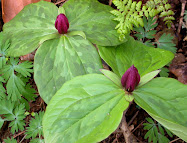I photographed a few before I picked them up. Once you see one and have a search image they are pretty easy to spot because they are usually white and round unlike the sharp edged shale and other rocks.
This particular spot is very good because I found several different species. I have found it is best to place them in a hard container like an old pill bottle so they don’t get crushed or lost in my field bag.
To identify them I have been using “How to Know the Eastern Land Snails” by J. B. Burch but that is hard to come by these days so I most often recommend going to Dan and Judy Doursons pdf at: http://www.clemson.edu/public/naturalist/2011_upstate_master_naturalist_class/pdf/snails_smoky_mtns.pdf
The Dourson's use the same features as Burch to determine the species.
First off I look at the shell and determine several factors such as the shell shape and lip type. The shapes are Pupa Shape, Beehive Shape, Heliciform Shape, Depressed Heliciform. Since I didn't find all of these shapes I thought I would identify the big one with the reflective lip. I didn't take a photo of the shape but the one on the left that I will identify is a Heliciform Shape.
The lip shape is easy.
Then I count the whorls, this one looks like it is what they would call five and half. I wanted to call it five but I couldn't find anything that fit the other features so I relented.
And measure the width. The tiny one on the right fell out when I cleaned off the big one so I thought I would include if for comparrison.
The Umbilicus is also important to know and there are basically 4 types, Imperforate, Perforate, Umbilicate and Rimate.
Then look for the teeth but these aren’t really teeth for chewing but they look like teeth. The ones I found that day didn't have any teeth so I included this one (below) from a previous time to demonstrate the teeth.
Using Doursons’ key I was able to determine that my big shell with the reflective lip is Mesodon normalis (Grand Globe). It is 21-38mm wide, five and half whorls, imperforate and has no teeth. Here it is in my hand.
Mesodon normalis (Grand Globe)
There is a little more involved than what I have shown here but it really is pretty simple, I just didn't have samples of all the possibilities. Anyway it is a fun winter activity.





































+DSCN5800+for+blog.jpg)



